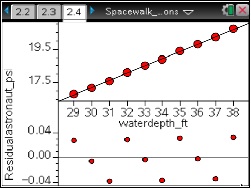NASA - Spacewalk Training

NASA - Spacewalk Training
In this activity, students will plot data, looks at patterns, and draw conclusions given a real-world context of astronauts training in the Neutral Buoyancy Laboratory (NBL) in Houston, TX.
Students will:
- explain what is meant by the direction, form and strength of the overall pattern of a scatter plot
- define the correlation coefficient, r, and describe what it measures
- write a regression equation and interpret the meaning of the slope and y-intercept in context of the problem
- explain what is meant by extrapolation and interpret a situation where extrapolation occurs
- make predictions based on the correct mathematical model
- plot residuals and interpret their graphical form.
The Neutral Buoyancy Laboratory (NBL) is a 202 ft (62 m) long, 102 ft (31 m) wide and 40 ft (12 m) deep pool located inside the NASA Sonny Carter Training Facility in Houston, Texas. The NBL allows astronauts to train for spacewalks in an environment resembling microgravity (weightlessness). Due to the size of the NBL, two different training activities can be performed at either end of the pool simultaneously. The NBL is large enough to hold full-sized mockups of the space shuttle cargo bay, flight payloads (like the Hubble telescope) and the International Space Station (ISS). Astronauts wear pressurized Extra-vehicular Mobility Unit (EMU) suits, which weigh approximately 280 lbs (127 kg) while training in the NBL. They are assisted by at least four professional scuba divers wearing regulation scuba gear. For every hour the astronaut plans to spend on a spacewalk, the team will spend seven hours training in the water. On a training day at the NBL, astronauts normally spend up to six consecutive hours in the pool. The scuba divers, however, are limited to five hours of dive time per day and this time is broken into at least two different dives.
Vernier EasyData,Vernier EasyLink and Vernier EasyTemp are registered trademarks of Vernier Science Education.

